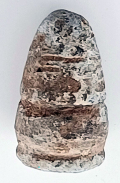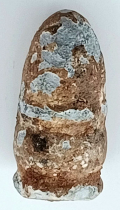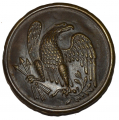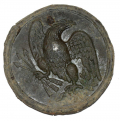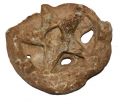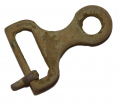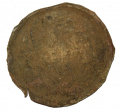site search
online catalog
Relics
Showing 281 to 300 out of 342
RARE 90-BORE (~.36 CALIBER) BULLET FOR CHRISTIAN SHARPS PISTOL
This is the scarce bullet for the Christian Sharps pistols manufactured between 1857-1858. Solid bullet, raised bands, tie ring, nipped sprue on base. This pattern of bullet, with extended ring,… (2022-2612B). Learn More »
RARE 90-BORE (~.36 CALIBER) BULLET FOR CHRISTIAN SHARPS PISTOL
This is the scarce bullet for the Christian Sharps pistols manufactured between 1857-1858. Solid bullet, raised bands, tie ring, nipped sprue on base. This pattern of bullet, with extended ring,… (2022-2612A). Learn More »
CONFEDERATE .36 CALIBER COLT REVOLVER BULLET – 3RD PATTERN, RICHMOND LABORATORY
.36 caliber bullet for Colt and other “Navy” revolvers. This is the later-war, enlarged, 3rd pattern bullet made at the Richmond Laboratory. This bullet has a more-bulbous nose, solid base and one… (2022-2506). Learn More »
$30.00 Each
SOLD
MAINE “VMM” CARTRIDGE BOX PLATE FROM ORANGE, VIRGINIA
These plates, measuring 56 X 87mm, followed the standard U.S. 1839 version, but with VMM stamped in the rolled brass indicating Volunteer Militia of Maine. These were paired on equipment with the… (1184-148). Learn More »
CIVIL WAR NCO ROUND EAGLE SHOULDER BELT PLATE
These plates were introduced in 1826 for use on the bayonet shoulder belt. When the bayonet was switched to wear on the waistbelt in the early 1840s these plates with hooks were relegated to use on… (1184-136). Learn More »
EARLY RELIC FIRE STRIKERS (A.K.A. STRIKE-A-LIGHTS)
Offered here are a variety of steel fire strikers; the “steel” part of “flint and steel.” A fire striker is a piece of carbon steel from which sparks are struck by the sharp edge… (160-93). Learn More »
FIRED .577 ENFIELD BULLETS RECOVERED AT GETTYSBURG BY JOHN CULLISON
This item was recovered by local Gettysburg resident John Cullison, who excavated relics on the field from 1935-1959. Cullison sold his collection to the famed Rosensteel family of Gettysburg, who… (R17332). Learn More »
DROPPED .54 CAL. MINIE BALLS RECOVERED AT GETTYSBURG BY JOHN CULLISON
This item was recovered by local Gettysburg resident John Cullison, who excavated relics on the field from 1935-1959. Cullison sold his collection to the famed Rosensteel family of Gettysburg, who… (R17331). Learn More »
US PATTERN 1826 EAGLE BREAST PLATE, FROM G.A.R. POST 551 COLLECTION (YORK SPRINGS, PA)
This Federal shoulder belt plate is of the regulation 1826 pattern. Constructed in the die-struck and rolled brass method, the brass accoutrement’s face shows a clear eagle in the center. Face has a… (2022-1849). Learn More »
RELIC WORLD WAR ONE BRITISH SMLE WIRE CUTTER HEAD
During World War One the ubiquitous wire cutters played an important role in trench raids and assaults. Leading elements would use these cutters to penetrate the enemies wire entanglements and clear a… (490-3926). Learn More »
RELIC – BIG BROKEN BRASS SPUR FROM ORANGE, VIRGINIA
This is about half of an excavated spur…very large and heavy western-style spur. This piece consists of one are and the neck/rowel. The other arm is broken off and missing. Measures approximately… (1184-389). Learn More »
FIELD-MADE COPY OF STAR AND CRESCENT CAPE PIN
This is an excavated relic from a camp near Orange, Virginia. Using a brass star and crescent cape pin, some creative or bored soldier made this piece. Creating a mold by pressing the original cape… (1184-288). Learn More »
DUG BRASS BULLET MOLD
This is a very nice brass bullet mold. In “dug” condition, the brass has an even green patina. Measures 4” long overall. The mold is stuck partially opened. It has two cavities; casting two .31… (1184-337). Learn More »
RELIC ISAAC & CAMPBELL KNAPSACK HOOK
This is an excavated Confederate knapsack buckle from an imported knapsack manufactured by S. Isaac Campbell & Company in London. This company supplied numerous articles of war to the… (1184-304). Learn More »
RELIC STATE OF NEW YORK “SNY” BELT PLATE
This is a nice excavated SNY belt plate. Pattern 1839 belt buckle with puppy-paw hooks. Beautiful brown face with the letters “SNY” in the center. Light wear over face with smooth chocolate brown… (2022-1554). Learn More »
$495.00
SOLD
SKIN ONLY OF A US PATTERN 1826 EAGLE CARTRIDGE BOX BREAST PLATE DUG AT FREDERICKSBURG
The face is slightly discolored from ground action leaving a mix of dark and light patina. The darker portion is along the bottom half of the eagle. The surface of the plate has a light waviness to it… (2022-1410). Learn More »
RELIC PAIR OF CIVIL WAR ENLISTED SHOULDER SCALES
Introduced in 1851 for mounted troops, brass shoulder scales were decorative, but were also meant to be a shoulder defense against saber cuts. In 1854/55 they became regulation for all branches of… (1184-299). Learn More »
CONFEDERATE .69 CALIBER “BRITISH SEA SERVICE” RIFLED MUSKET BULLET
Collectors call this a “British Sea Service” bullet because of its reference in a very early bullet reference book. However, there is no research to support this. It is a Confederate-made bullet… (1184-365). Learn More »
CONFEDERATE .50 CALIBER “MACON” CARBINE BULLET
Known as the Macon carbine bullet for no particular reason, this bullet features a round nose, two grooves, and a solid base. Bullet has been fired but remains in excellent condition with only faint… (1184-369). Learn More »
RELIC .36 CALIBER BRASS TWO-CAVITY BULLET MOLD – RECOVERED NEAR FREDERICSBURG
This is an excavated .36 caliber two cavity bullet mold for “Navy” revolvers. The mold halves are brass with a steel sprue cutter, screw, and pins. The mold is approximately 5” in overall… (2022-1313). Learn More »
Showing 281 to 300 out of 342
Most Popular
Historical Firearms Stolen From The National Civil War Museum In Harrisburg, Pa »
Theft From Gravesite Of Gen. John Reynolds »
Selection Of Unframed Prints By Don Troiani »
Fine Condition Brass Infantry Bugle Insignia »
Large English Bowie Knife With Sheath 1870’S – 1880’S »
Imported (Clauberg) Us Model 1860 Light Cavalry Officer's Saber »
featured item
RARE CONFEDERATE SECOND NATIONAL / NAVAL ENSIGN
This Second National pattern Confederate flag precisely fits the dimensions for a Confederate Naval Ensign laid out by CS Secretary of the Navy Stephen Mallory on May 26, 1863, which specify a width-to-length ration of 1:1.5 where the official ratio… (1268-661). Learn More »



